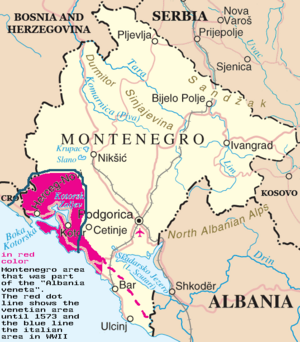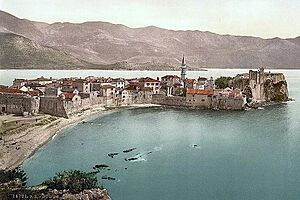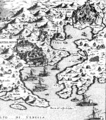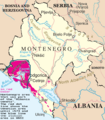Albania veneta facts for kids
Albania Veneta (which means Venetian Albania) was the name for lands that belonged to the Republic of Venice. Venice was a powerful city-state in Italy. These lands were located in a region called southern Dalmatia, which is now part of Montenegro and Albania. Venice controlled this area from 1420 until 1797.
Contents
Where was it?
At first, Albania Veneta included the coastal areas of what is now northern Albania and the coast of Montenegro. However, in 1571, the Ottomans (a powerful empire from Turkey) took over the parts in Albania and southern Montenegro.
What does the name mean?
The word "Veneta" in Albania Veneta was used to show that this area belonged to Venice. This helped people tell it apart from the "Ottoman Albania" (called Albania Ottomana), which was a different area controlled by the Ottomans. That Ottoman area stretched from Kosovo to southern Albania.
Geography of the Region
The Venetian lands stretched from the southern borders of the "Republic of Ragusa" (which is now the city of Dubrovnik in Croatia) down to Durrës in coastal Albania. These territories were always close to the Adriatic Sea, usually no more than 20 kilometers (about 12 miles) inland.
After 1573, the southern border moved to a village called Confin (Kufin), near Budva. This happened because the Ottomans had conquered other towns like Bar and Ulcinj. The main part of Venice's control was around the "Bocche di Cattaro" (which means Bay of Kotor). This area included small cities like Cattaro (Kotor), Risano (Risan), Perasto (Perast), Teodo (Tivat), Castelnuovo (Herceg Novi), Budua (Budva), and Spizza (Sutomore).
History of Albania Veneta
Venice began to take control of small villages in southern Dalmatia around the 900s. Over time, the local language, called "Dalmatian," slowly changed and became more like the Venetian language. But it wasn't until the 1300s that the Republic of Venice was able to connect all its territories around the Bay of Kotor.
These Venetian lands around Cattaro (Kotor) were ruled by Venice from 1420 to 1797. They were known as Albania Veneta, a special province of the Republic of Venice.
When the Turks started conquering parts of the Balkans in the 1400s, many Christian Slavs moved to Venetian Dalmatia for safety. Because of this, Albania Veneta started to have a large population of Serb and Albanian people. By the end of the 1600s, the people who spoke Romance languages (like Italian or Venetian) in Albania Veneta were no longer the majority.
After Napoleon's armies conquered and ended the Republic of Venice in 1797, the area of Albania Veneta changed hands many times:
- In 1805, it became part of Napoleon's "Kingdom of Italy."
- In 1809, it was part of the French "Illyrian Provinces."
- Finally, in 1815, it came under the control of the Habsburg Empire (the Austrian Empire).
Under Habsburg rule, Albania Veneta was part of "Austrian Dalmatia." In 1878, at a meeting called the "Congress of Berlin," another 40 square kilometers (about 15 square miles) around Sutomore were added to this territory.
The borders of the old Venetian province of Albania Veneta changed again in 1918. This was when the Kingdom of Yugoslavia was created. However, the old borders were brought back from 1941 to 1943 during World War II. At that time, Mussolini's Kingdom of Italy took over the territories around Cattaro. This area was called Provincia di Cattaro and was part of the Italian "Governatorato di Dalmazia."
After World War II, there was no longer any political area linked to Venice's historical presence in southern Dalmatia. The area became a permanent part of Yugoslavia. Today, the old Albania Veneta is a coastal region in the independent country of Montenegro.
People Who Spoke Venetian in Albania Veneta
According to a historian named Luigi Paulucci, who wrote about the Bay of Kotor in 1810, most people in the cities of Albania Veneta spoke Venetian. About 66% of the people in towns like Cattaro, Perasto, and Budua spoke Venetian during the centuries when the Republic of Venice ruled.
However, in the areas further inland, more than half the people spoke Serbo-Croatian after the early 1700s. Paulucci also noted that near the border with Albania, there were large groups of Albanian-speaking people. For example, in Dulcigno (Ulcinj), about half the people spoke Albanian, a quarter spoke Venetian, and a quarter spoke Slavic languages.
When the French ruled the Cattaro area, schools taught in Italian. This was when the former Albania Veneta was part of Napoleon's "Kingdom of Italy." A historian named Marko Trogrli wrote that French officials wanted the schools in Dalmatia to be like the schools in the rest of Napoleon's Kingdom of Italy, and teaching was done in Italian.
During the 1800s, wars for Italy's independence from the Austro-Hungarian Empire made it difficult for Italian (or Venetian-speaking) communities in southern Dalmatia.
Because of this, an Austrian census in 1880 showed that in Cattaro, there were only 930 people who identified as ethnic Italians. This was about 32% of the total population of 2910 people. By the 1910 Austrian census, the number of Italians in that city had dropped even more, to only 13.6%.
Today, there are about 500 Italian speakers in Montenegro. They mostly live in the areas of Cattaro (Kotor) and Perasto (Perast). They form a group called the "Comunitá Nazionale Italiana del Montenegro."
Most of the Italian-speaking people in Dalmatia disappeared after World War II. One linguist estimated that Italians made up about 33% of the Dalmatian population during the Napoleonic wars. Now, there are only about 300 Italians in Croatian Dalmatia and 500 Italians in coastal Montenegro.
Images for kids







